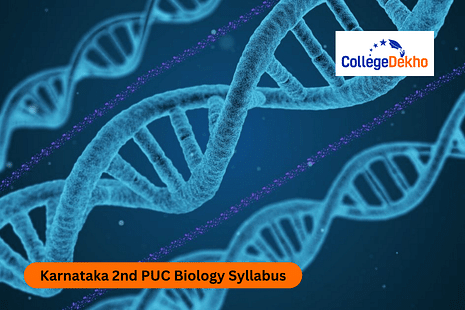- Karnataka 2nd PUC Latest Updates 2025
- Karnataka 2nd PUC Biology Syllabus 2024-25 PDF
- Karnataka 2nd PUC Biology Marking Scheme 2024-25
- Karnataka 2nd PUC Biology Syllabus 2024-25
- Karnataka 2nd PUC Biology Deleted Syllabus 2024-25
- How to Download Karnataka 2nd PUC Biology Syllabus 2024-25?
- Karnataka 2nd PUC Biology Question Paper Pattern 2024-25
- Karnataka 2nd PUC Biology Question Paper Format 2024-25
- Karnataka 2nd PUC Biology Preparation Tips 2024-25
- Benefits of learning Karnataka 2nd PUC Biology
- Faqs


Never Miss an Exam Update
Karnataka 2nd PUC Biology Syllabus 2024-25 can be downloaded from the official website of the Karnataka School Examination Board at kseab.karnataka.gov.in. The blueprint and model test papers have been uploaded online. The theory paper will be conducted for 70 marks and the remaining marks will be provided for the practical exam. According to the latest blueprint uploaded online, the theory paper will consist of a total of 105 marks including internal choices. The question paper will include objective-type questions, very short answer-type questions, short answer-type questions, and long answer-type questions.
Make sure to practice as many Karnataka 2nd PUC Biology Model Paper 2024-25 as possible for an effective revision. This will help the students to enhance their preparation and check on their weak points. Check out more information about the Karnataka 2nd PUC Biology Syllabus 2024-25 here:
Also Read: Karnataka 2nd PUC Biology Previous Year Question Paper
Karnataka 2nd PUC Latest Updates 2025
- March 7, 2025: The Department of Pre-University Education, Karnataka started conducting the Karnataka 2nd PUC exam 1 2025 on March 1 that will end on March 20, 2025.
- March 7, 2025: DPUE will release the Karnataka 2nd PUC result 2025 on April 10, 2025 tentatively as per previous year's trend.
Karnataka 2nd PUC Biology Syllabus 2024-25 PDF
Students can download the updated Karnataka 2nd PUC Biology Syllabus 2024-25 here:
Karnataka 2nd PUC Biology Marking Scheme 2024-25
Students can refer to the latest Karnataka 2nd PUC Biology Marking Scheme 2024-25 from the table given below:
Chapter | No. of Periods | Marks |
|---|---|---|
1. Sexual reproduction in flowering plants | 12 | 11 |
2. Human reproduction | 11 | 10 |
3. Reproductive health | 7 | 6 |
4. Principles of Inheritance | 15 | 13 |
5. Molecular basis of Inheritance | 15 | 13 |
6. Evolution | 8 | 7 |
7. Human health and disease | 13 | 11 |
8. Microbes in Human welfare | 8 | 7 |
9. Biotechnology: Principles and Processes | 8 | 7 |
10. Biotechnology and its applications | 7 | 6 |
11. Organism and population | 6 | 6 |
12. Ecosystem | 5 | 4 |
13. Biodiversity and Conservation | 5 | 4 |
Total | 120 | 105 |
Karnataka 2nd PUC Biology Syllabus 2024-25
The chapter-wise Karnataka 2nd PUC Biology syllabus 2024-25 has been provided below:
- Sexual reproduction in flowering plants
Flower structure; development of male and female gametophytes; pollination – types, agencies and examples; outbreeding devices; pollen-pistil interaction; double fertilization; post fertilization events – development of endosperm and embryo, development of seed and formation of fruit; special modes – apomixis, parthenocarpy, polyembryony; Significance of seed dispersal and fruit formation.
- Human reproduction
Male and female reproductive systems; microscopic anatomy of testis and ovary; gametogenesis – spermatogenesis and oogenesis; menstrual cycle; fertilisation, embryo development upto blastocyst formation, implantation; pregnancy and placenta formation (elementary idea); parturition (elementary idea); lactation (elementaryidea).
- Principles of inheritance and variation
Heredity and variation: Mendelian inheritance; deviations from Mendelism – incomplete dominance, co-dominance, multiple alleles and inheritance of blood groups, pleiotropy; elementary idea of polygenic inheritance; chromosomal theory of inheritance; chromosomes and genes; sex determination – in humans, fruit fly, birds, honey bee and grasshopper; linkage and crossing over; mutation; sex linked
inheritance: Mendelian disorders in humans; chromosomal disorders in humans.
- Molecular basis of inheritance
Search for genetic material and DNA as genetic material; structure of DNA and RNA; DNA packaging; DNA replication; central dogma; transcription, genetic code, translation; gene expression and regulation
– lac operon; human genome project; DNA fingerprinting.
- Evolution
Origin of life; biological evolution and evidences for biological evolution (palaeontology, comparative anatomy, embryology and molecular evidences); Darwin’s contribution, modern synthetic theory of evolution; mechanism of evolution – variation (mutation and recombination) and natural selection with
examples, types of natural selection; gene flow and genetic drift; Hardy – Weinberg’s principle; adaptive radiation; human evolution.
- Human health and diseases
Pathogens; parasites causing human diseases (common cold, dengue, chikungunya, typhoid, pneumonia, amoebiasis, malaria, filariasis, ascariasis, ring worm) and their control; Basic concepts of immunology – vaccines; cancer, HIV and AIDS; Adolescence – drug and alcohol abuse.
- Microbes in human welfare
In household food processing, industrial production, sewage treatment, energy generation and microbes as biocontrol agents and biofertilisers. Antibiotics.
- Biotechnology – Principles and processes
Genetic Engineering (recombinant DNA technology).
- Biotechnology and its applications
Applications of biotechnology in health and agriculture: human insulin and vaccine production, stem cell technology, gene therapy; genetically modified organisms – Bt crops; transgenic animals; biosafety issues, biopiracy and biopatents.
- Biodiversity and its conservation
Concept of biodiversity; patterns of biodiversity; the importance of biodiversity; loss of biodiversity; biodiversity conservation; hotspots, endangered organisms, extinction, Red Data Book, biosphere reserves, national parks, sanctuaries, and Ramsar sites.
Karnataka 2nd PUC Biology Deleted Syllabus 2024-25
Students can refer to the deleted topics or chapters of the reduced Karnataka 2nd PUC Biology Syllabus 2024-25:
Chapters | Page Number | Deleted topics |
|---|---|---|
Chapter 1: Reproduction in Organisms | 3–18 | Full Chapter |
Chapter 9: Strategies for Enhancement in Food Production | 165–176 178 | Full Chapter |
Chapter 13: Organisms and Populations | 220 221–222 223–225 225–226 | 13.1 Organism and Its Environment 13.1.1 Major Abiotic Factors 13.1.2 Responses to Abiotic Factors 13.1.3 Adaptations Ques. 1, 2, 3, 9, 10, 11, 12 |
Chapter 14: Ecosystem | 250–252 253–254 254–255 255 | 14.6 Ecological Succession 14.6.1 Succession of Plants 14.7 Nutrient Cycling 14.7.1 Ecosystem – Carbon Cycle 14.7.2 Ecosystem – Phosphorus Cycle 14.8 Ecosystem Services |
Chapter 16: Environmental Issues | 270–286 | Full Chapter |
How to Download Karnataka 2nd PUC Biology Syllabus 2024-25?
Students can follow the simple procedure given below to download the latest blueprint for Biology:
- Step 1: You must first visit the official website of the Karnataka School Examination Board at kseab.karnataka.gov.in.
- Step 2: The home page will open on your screen. Scroll down and go to the DOCUMENTS section.
- Step 3: Click on the PUC option. Now, click on the Question papers link.
- Step 4: A new page will open on your screen. Select the “2024-25 Model question papers and their blueprints for the II PUC Examination & related Circular”
- Step 5: Now click on the Biology option to download the blueprint of the papers accordingly.
Karnataka 2nd PUC Biology Question Paper Pattern 2024-25
The following format will be followed by the Karnataka School Examination Board to create the question paper for Biology subject during the initial board exams:
Question Paper Parts | Question Type | Number of Questions | Marks |
|---|---|---|---|
PART – A | I. MCQ | 15 | 15 |
PART – A | II. Fill in the Blanks | 05 | 05 |
PART – B | III. Short Answers (2 Marks) | 07 | 14 |
PART – C | IV. Short Answers (3 Marks) | 07 | 21 |
PART – D | V. Long Answers (5 Marks) | 07 | 35 |
PART – D | VI. Long Answers (5 Marks) | 03 | 15 |
TOTAL | - | 44 | 105 |
Karnataka 2nd PUC Biology Question Paper Format 2024-25
Students can check out the types of questions that will appear in the board exams from the pointers given below:
- The Question paper consists of parts A, B, C, D and E
- Part A - I consist of 15 Multiple choice questions, Part A – II consists of 5 up-the-blank questions
- All the questions of Part A – I and II are to be answered compulsorily
- Part B consists of 7 short answer type questions carrying 2 marks each, out of which 5 questions to be answered
- Part C consists of 7 short answer type questions carrying 3 marks each, out of which 5 questions to be answered
- Part – D consists of V and VI. Part D – V consists of 7 long answer-type questions carrying 5 marks each, out of which 4 questions are to be answered. Part D – VI consists of 3 long answer-type questions carrying 5 marks each, out of which 1 question is to be answered.
- Part E consists of questions for visually challenged students only after question number 44.
Karnataka 2nd PUC Biology Preparation Tips 2024-25
From this year onwards, the state board has decided not to conduct supplementary examinations for class 12 students. Instead, there will be ‘three annual examinations’ which are, Exam 1, Exam 2, and Exam 3. Students who will be appearing for the Karnataka 2nd PUC exam 2025, can follow the preparation tips given below:
- Start your exam preparation by knowing the syllabus and exam pattern.
- Know the highest weightage carrying topics and chapters in the syllabus.
- Create an effective study schedule giving equal time to each topic of the subject. Maintain the schedule till the exam.
- Make a separate notebook for Biology and jot down your notes. Study from your handwritten notes and you will remember much better what you have prepared.
- Refer to the recommended Karnataka Board 2nd PUC Biology books. Use proper reference books if required.
- Solve the Karnataka 2nd PUC Biology model papers and previous years' question papers to know the types and difficulty level of the questions.
- While writing in the examination hall, write short and crisp answers. Draw diagrams and label them wherever necessary in the answers.
Benefits of learning Karnataka 2nd PUC Biology
- For class 12th students in Karnataka Board, Biology is important, particularly for those who is aiming for medical or scientific fields as it provides a foundation for understanding complex biological concepts.
- It is one of the main subjects for the class 12 science students who is preparing for the NEET examination.
- The Karnataka Board 2nd PUC Biology syllabus is similar to the NCERT syllabus which is an important study material for the NEET exam preparation.
- The Karnataka Board 2nd PUC Biology books are prepared by the Karnataka Board so that students can undergo a conceptual learning, leading to an enhancement of the student's deeper appreciation for the natural world.
Students must try to complete the Karnataka 2nd PUC Biology Syllabus 2024-25 as soon as possible so that they can invest their time in revision. Revision can be done through model test papers available online or previous year's question papers. Try to study through a well-curated study plan to complete your syllabus on time.
FAQs
In order to qualify the Karnataka Board 2nd PUC Exam 2025, a student must score a minimum of 35 per cent marks in all the subjects including theory and practical exams. As per the Karnataka 2nd PUC Passing criteria, students must score at least 24 marks as passing marks in the 2nd PUC board examination, question paper of 80 marks.
The maximum weightage carrying chapters in Karnataka 2nd PUC Biology syllabus 2025 are Molecular Basis of Inheritance, Principle of Inheritance, Human, Health and Disease Sexual Reproduction in Plants, and Human Reproduction.
The maximum mark allotted for the Karnataka 2nd Biology exam 2025 is 100. Out of these, 70 marks will be given for the theory exam and the remaining 30 marks will be for the practical exam.
There are 16 chapters in total in the Karnataka 2nd PUC biology syllabus 2024-25 out of which 6 chapters have been deleted.
Yes, the Karnataka 2nd PUC biology syllabus for the academic year 2024-25 has been reduced. Go through the detailed syllabus provided above on this page.
Karnataka 2nd PUC Biology Syllabus 2024-25 can be downloaded from the official website of KSEAB at kseab.karnataka.gov.in
Was this article helpful?

















